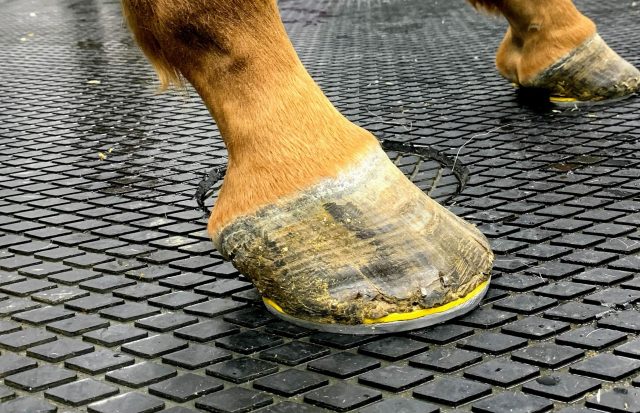
A Common (and Costly) Farrier Mistake
In this excerpt from Shoeing the Modern Horse by Steven Kraus, CJF, and Katie Navarra, the head of Farrier Services at Cornell University explains one of the ways things can go wrong when you hire a farrier, and what to watch for to keep your horse sound.

As in human medicine, not every farrier procedure turns out perfectly. Even with solid training, it is possible for trimming or shoeing to create lameness. Whether it is from lack of knowledge or simply an accident, a farrier can make a mistake.
The horse’s hooves and legs are designed to absorb the loading forces of each footfall and transmit those pressures evenly. When the length of the hoof, the type of shoe, or hoof angle are incorrect for a horse, it will alter his movement, increase the risk of injury, and may be painful.
Skilled farriers make the average trimming and shoeing process look easy. But what makes good farriery so difficult is that there is no one way to trim and shoe—it is as much an art as it is a science. The practitioner must be able to visualize what he would like the horse’s hooves to look like at the end of the job. When all goes as planned, a thorough job can take an hour or less for a routine visit. The horse goes back to life as usual as if he had just walked out of a spa. A nip that is too short or a nail too close to sensitive tissues can leave a horse sore and lame.
It is only human to make mistakes, and it can likely be corrected within one or two normal shoeings. Repeated mistakes are what can end a horse’s career.
What’s one common farrier mistake?
Incorrect angles.
Expert pool players know how crucial angles are to playing the game well. Without a proper line, the ball will never make it into the pocket. An angle is as critical in horse hooves as it is in billiards.
Generally, on the average horse, the front feet dorsal angle is close to a 50-degree angle in relationship to the ground. The dorsal angle of the hind feet is usually several degrees higher than in the front. This is an average—there is no perfect angle. The horse’s hoof-pastern axis should align with his shoulder angle for ideal conformation. The “correct” angle is the one that keeps the horse’s stance aligned and moving freely, even if it varies from the average.
“Balance” is a buzzword, but it is often not well understood. The term describes how the bottom of the hoof makes contact with the ground and dissipates the force associated with movement. The combination of hoof angle and length influences how this transfer of pressure happens, and it is referred to as the hoof-pastern axis.

Photo by Steven Kraus
Horses’ hooves that get too steep or too low-angled change this critical alignment, and the phrase unbalanced feet may be used. Too steep of a hoof angle is classified as broken forward, while one that is too shallow is called broken back. Either extreme deviation from normal puts excessive strain on the coffin and pastern joints—of course, there are always special cases that fall outside of the “normal” range.
Misalignment of angles increases the concussive forces a horse experiences in his legs. Uneven weight distribution overloads tendons and ligaments and can eventually change the bone structure. That bone changes in shape and density over time, producing formations called osteophytes. As we’ve already discussed, the term used to describe the process that happens when the bone adapts to the force exerted on it is “Wolf’s Law.”
Unbalanced feet can be one cause of suspensory or collateral ligament tears. These injuries are costly to correct because it requires veterinary care along with therapeutic shoeing until healing is finished. Injuries like this also tend to require several months of rehabilitation, all while the horse is out of work. Even after the investment in healing, there will also always be a question of “what if?” What if that spot is weaker and more prone to another injury, or will the horse be able to get back to work?
This excerpt from Shoeing the Modern Horse by Steven Kraus, CJF, and Katie Navarra is reprinted with permission from Trafalgar Square Books. You can purchase the book here.






